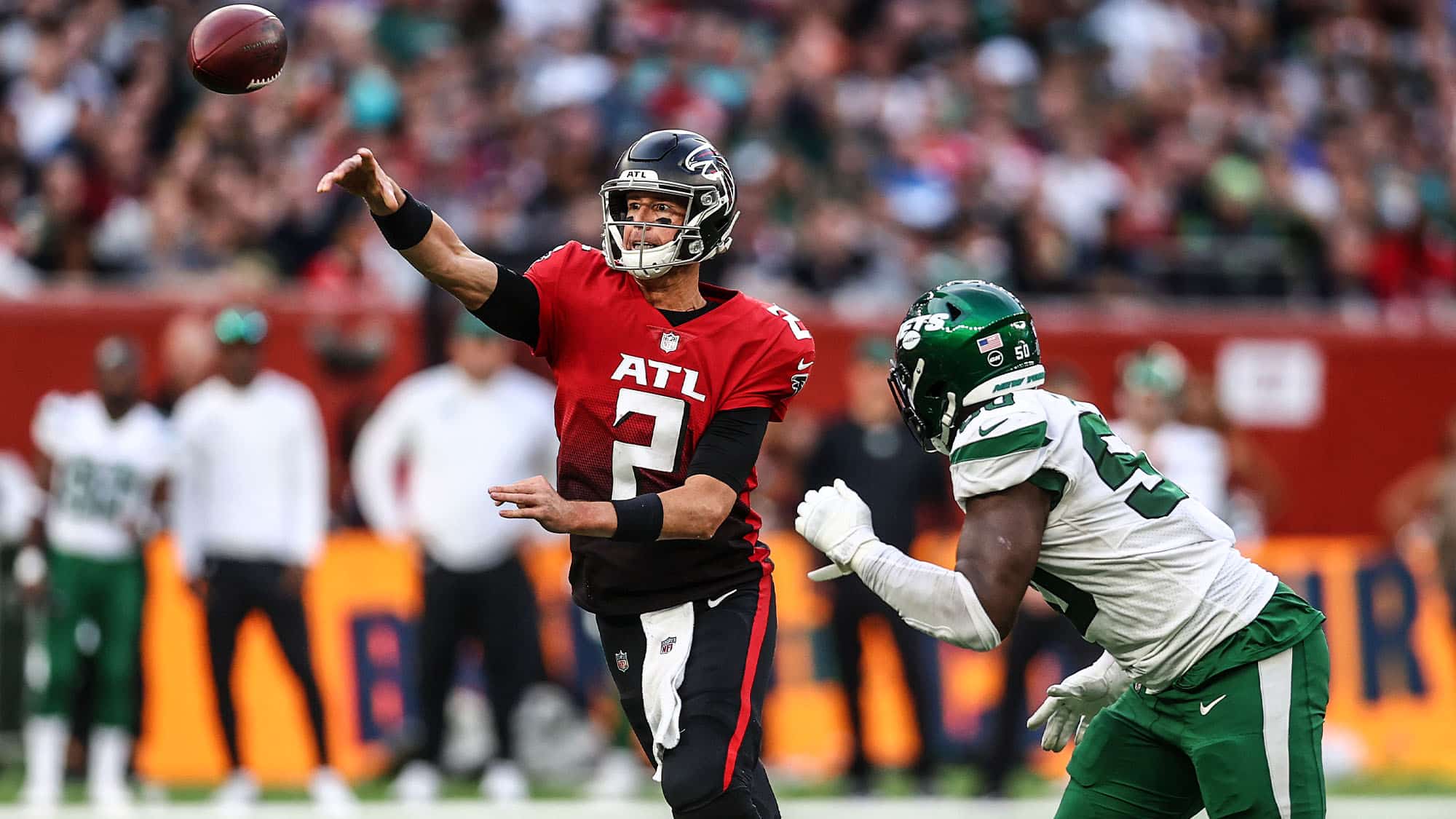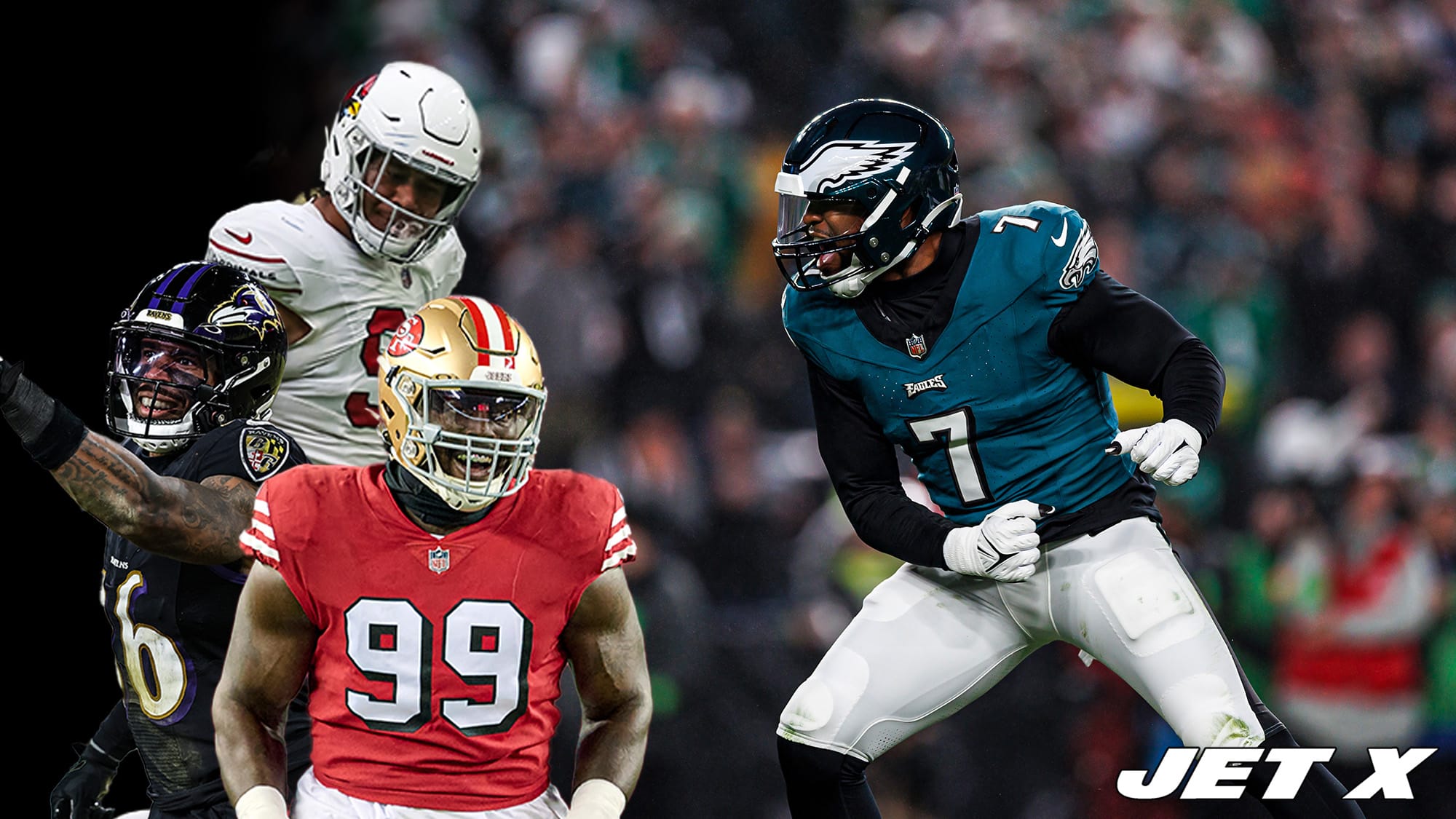The New York Jets’ pass rush in London was better than you likely thought
One of the most maligned position groups in the New York Jets’ disappointing London loss to the Atlanta Falcons was the defensive line. Many observers – myself included – were appalled at the apparent lack of a pass rush against Atlanta’s exploitable offensive line. Falcons quarterback Matt Ryan uncorked 45 pass attempts without taking a sack.
While it was hard to notice while watching live on the TV broadcast, the Jets’ pass rush was actually pretty good. Ryan and the Falcons just did a great job of mitigating it.
I foresaw this type of performance and the ensuing reaction in my breakdown of the Jets’ defensive line against the Falcons’ offensive line entering the game. Here’s what I wrote on Saturday:
“There is a chance that the dominance of the Jets’ defensive line over Atlanta’s offensive line could manifest itself in a way that does not result in tangible production or flashy plays.
The Falcons aren’t foolish. They know their offensive line will be overmatched if they ask it to hold up against the Jets’ defensive line for long periods of time.
Atlanta will likely rush the ball out to prevent the Jets’ pass rush from doing any damage. This is what head coach Arthur Smith did against the Washington Football Team’s intimidating defensive line last week. Matt Ryan released the ball in under 2.5 seconds on 72.1% of his pass attempts, ranking second-highest in the league behind only Ben Roethlisberger in Week 4.
If this happens, the Jets’ pass rush will likely not post the splashiest numbers, in turn drawing criticism for not making an impact.
But that intimidation factor is the very definition of impact. By forcing Atlanta into a quick-game, checkdown-heavy approach merely based upon the threat of what they could do, the pass rush will have severely limited the explosive potential of Atlanta’s offense without even doing anything.”
Lo and behold, this is exactly how things played out.
Ryan released 62.2% of his pass attempts in under 2.5 seconds, which ranked third-highest among qualified quarterbacks in Week 5 (prior to Monday Night Football).
How is a defense supposed to get sacks when a quarterback is getting the ball out that fast? The average sack this season has taken 3.41 seconds to occur, and 84% of all sacks have taken more than 2.5 seconds to occur. It’s damn near impossible to sack a quarterback when he plays the way Ryan did.
Despite the lack of sacks, the Jets’ pass rushers were winning their battles frequently. They just weren’t given enough time to convert their wins into sacks.
New York’s defense finished with eight quarterback hits. That is well above the 2021 league average of quarterback hits per game (5.8) and above the Jets’ elite season average of 7.4, which ranks third-best in the league.
Ryan was hurrying the ball out but still faced pressure often. He ranked 25th out of 32 qualified quarterbacks in average time from snap to throw (2.46 seconds) but faced pressure on the ninth-highest percentage of his dropbacks (35.6%).
The disparity between those two metrics is an indicator that the Jets’ pass rushers were winning far more frequently than they should have been expected to. On average, there is a direct correlation between time to throw and pressure rate – more time to throw equals taking pressure more frequently and vice versa.
If a quarterback ranks highly in pressure rate but low in time to throw, it is a sign that the offensive line was getting beaten up (the inverse means the offensive line is protecting well – that’s what the Jets’ offensive line did for Zach Wilson).
Get Started: Learn More About Becoming A Jet X Member
Perhaps this is the best way to sum it up: Ryan was forced into the third-most pressured dropbacks among all quarterbacks in Week 5 (16) despite throwing the second-most pass attempts in under 2.5 seconds (28). That is the mark of a strong pass-rushing performance hidden by a quick-passing offense.
Atlanta’s quick-minded game-plan is not the only thing that stifled the New York defense’s ability to get sacks and masked the impact of the pressure the Jets did generate. Ryan himself was just flat-out great under pressure. He threw darts with defenders in his face all afternoon. Ryan’s 111.7 passer rating under pressure (11/16 for 121 yards, 1 TD, 0 INT) ranked third-best in Week 5.
Combine a quarterback who is unaffected by the pressure with an offense predicated upon quick passes and you get zero sacks – regardless of how good the pass rush actually was at winning battles and creating pressure.
For an offense, getting the ball out quickly to protect the quarterback should come with a price. That price is the minimization of explosive-play potential. By rushing the ball out, the offense keeps the quarterback safe but trades away the ability to throw the ball down the field.
New York’s pass rush successfully intimidated the Falcons into running a conservative quick-passing offense. Ryan’s average pass traveled only 8.0 yards downfield, ranking 25th out of 32 qualified quarterbacks.
The problem is that the secondary did not hold up its end of the bargain by containing those shallow throws.
The Jets’ cornerback unit had its worst outing of the season. They could not stop the short, quick passes that the pass rush forced Ryan into making. Bryce Hall, Brandin Echols, and Michael Carter II combined to allow 17 catches on 24 targets for 182 yards (season-high for the unit) and 10 first downs (also a season-high).
Ryan led all quarterbacks in Week 5 with 27 completions on passes thrown under 20 yards downfield. He went 27-of-34 for 293 yards, two touchdowns, and zero interceptions on those throws (122.2 rating).
Sacks never tell the whole story of how a pass-rush unit or individual pass rusher played. In this case, we saw a good pass-rushing performance fly under the radar thanks to three things: an offensive game-plan willing to play conservatively to limit the pass rush, a secondary that did not make the offense pay for that approach, and a veteran quarterback who was cool and collected under the pressure.
Chargers’ head coach Brandon Staley did a marvelous job of summing up the misleading nature of sacks ahead of his team’s Week 5 game against the Cleveland Browns. Staley’s explanation feels relevant to this particular outing by the Jets’ pass rush.
WE STAN A 🤴 pic.twitter.com/C4MqQgJBFg
— Will Brinson (@WillBrinson) October 9, 2021
John Franklin-Myers led the pack in his first game after signing a lucrative contract extension. He collected four pressures over 36 pass-rush snaps for an 11.1% pressure rate (2020 EDGE average: 9.7%).
Here are some of the other pass-rush leaders (of course, keep in mind that the production standards in this game were lower considering the opponent’s release speed):
- IDL Quinnen Williams: 3 pressures on 31 pass-rush snaps (9.7% – 2020 IDL average: 7.0%)
- EDGE Shaq Lawson: 3 on 20 (15.0%)
- EDGE Bryce Huff: 2 on 34 (5.9%)
- IDL Nathan Shepherd: 2 on 11 (18.2%)
- IDL Sheldon Rankins: 2 on 28 (7.1%)
Most notably, this was a promising step forward for Lawson, whose total of three pressures in this game matches his total over the prior four games combined.
The Jets also got four pressures out of their blitzers (two from Jarrod Wilson and one each from Jamien Sherwood and Quincy Williams). To boot, edge rusher Tim Ward collected two pass deflections as a rusher over only seven pass-rush snaps.
It’s also worth noting that the Jets had two sack-worthy plays wiped away. Quincy Williams had an opening-drive sack called back due to a questionable roughing the passer penalty, and Sheldon Rankins had a likely sack erased as he was grabbed by center Matt Hennessy, who was ensuingly called for a holding penalty.
Always make sure to take everything into context when evaluating an individual player or a particular facet of a football team. There are so many different factors that go into determining the end result. In this game, the Jets’ pass rush did a nice job regardless of the zero in the sack column.
With that being said, I do think it is fair to say that the Jets’ pass rush could have done more against a Falcons’ offensive line that was ripe for the picking. In particular, Williams’ total of three pressures – while solid – is somewhat disappointing considering he was going up against left guard Jalen Mayfield, the lowest-graded pass-blocking guard in the NFL at Pro Football Focus entering the game.
Overall, this was a good outing for the Jets’ pass rush. It was not as dominant of a performance as it could have been considering the opponent, but it was also not as bad of a performance as the sack column suggests.












Surprised, but Matt Ryan is a great QB, and Arthur Smith out coached the Jets. Would agree that Lawson is a pleasant surprise, but Shepherd had a couple of devastating penalties, couldn’t believe he was on the field, but very impressive pressure rate. Ward certainly has length, could be an interesting pick up.